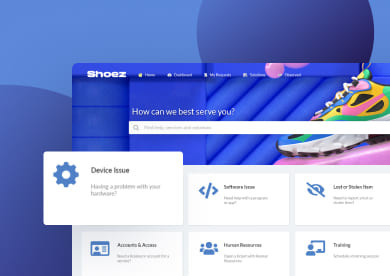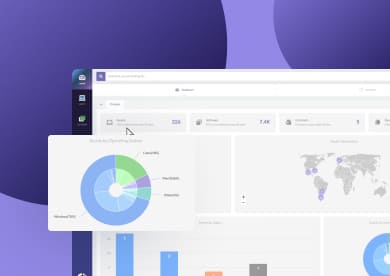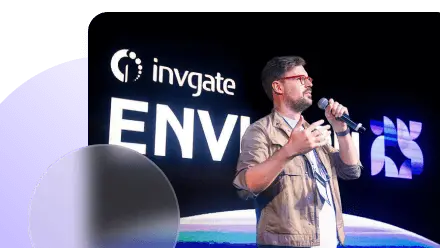GRC software helps organizations manage Governance, Risk, and Compliance (GRC) in one place — streamlining processes, ensuring transparency, and keeping you audit-ready.But picking the right tool? That’s no small task. GRC software solutions come in all shapes and sizes, with different capabilities, price tags, and use cases depending on your team’s needs and your organization’s goals.
That’s why we’ve rounded up the best GRC tools for 2025. And yes, InvGate Asset Management made the list. It stands out for helping IT teams simplify compliance, centralize data, and improve risk visibility without breaking the bank.
Let's take a look at the best GRC tools to consider!
What is GRC software?
GRC software is a tool that helps organizations manage Governance, Risk, and Compliance in one place. It streamlines Policy Management, risk tracking, and regulatory compliance — making the job easier for GRC professionals.
By centralizing these processes, it helps reduce risk, improve visibility, and keep everything aligned with internal and external requirements.
GRC tools comparison
| Tool | Best for | Pricing | Free trial/Demo |
| InvGate Asset Management | IT Asset Management with built-in GRC features, compliance, and automation for IT teams | Starter: $0.21/node/month billed annually (min. $1,250). | Free 30-day trial available |
| RSA Archer | Comprehensive enterprise GRC and Risk Management across multiple domains | Custom pricing, not publicly disclosed | Demo available upon request |
| AuditBoard | Cloud-based audit, risk, and compliance management with strong collaboration tools | Custom pricing, not publicly disclosed | Demo available upon request |
| LogicGate Risk Cloud | Flexible, no-code workflows for Risk and Compliance automation | Subscription-based, custom pricing | Demo available upon request |
| MetricStream ConnectedGRC | Enterprise-scale integrated risk, compliance, audit, and cybersecurity | Subscription-based, custom pricing | Demo available upon request |
| Diligent One Platform (ex HighBond) | Centralized GRC with strong automation and audit capabilities | Subscription-based, custom pricing | Demo available upon request |
| LogicManager | Cloud-based Enterprise Risk Management with customizable features | Subscription-based, custom pricing | Demo available upon request |
| ServiceNow GRC | Large organizations needing integrated GRC with ServiceNow ecosystem | Subscription-based, custom pricing | Demo available upon request |
| SAI360 | Broad GRC modules including IT risk, vendor risk, and compliance | Subscription-based, custom pricing | Demo available upon request |
| SureCloud GRC Platform | Dynamic risk intelligence and continuous control monitoring | Subscription-based, custom pricing | Demo available upon request |
| Hyperproof | Compliance management and audit readiness with 70+ integrations | Flexible, custom pricing | Demo available upon request |
The 10 best GRC platforms for IT
Finding the right GRC platform can be tricky — there are plenty of options out there, each designed to tackle Governance, Risk, and Compliance from a different angle. To help you cut through the noise, we’ve rounded up the 10 best GRC tools for IT.
These GRC software solutions cover everything from risk tracking and Policy Management to audit readiness and compliance monitoring, giving you a clear picture of which Governance, Risk, and Compliance software best fits your organization’s needs.
#1. RSA Archer
 Developed by Archer Technologies, Archer RSA is a proprietary, paid integrated Risk Management solution known for its flexibility and comprehensive approach to GRC.
Developed by Archer Technologies, Archer RSA is a proprietary, paid integrated Risk Management solution known for its flexibility and comprehensive approach to GRC.
It offers multiple deployment options, including on-premises and hosted (SaaS) environments, allowing organizations to choose the setup that best fits their needs.
Archer features
- Centralized data repository – Serves as a unified source for all risk-related data, ensuring consistency and accessibility.
- Workflow automation – Automates GRC processes, enhancing efficiency and reducing manual intervention.
- Policy Management and Compliance Management – Facilitates the storage of policies and regulations, manages controls, conducts gap analyses, and records deficiencies through findings and remediation.
- Risk Management solutions – Assesses, monitors, and addresses risks consistently by consolidating risk information from across the organization into one central solution.
- Incident Management – Enables organizations to track and respond to incidents effectively, ensuring timely resolution and documentation.
- Third-party Risk Management – Provides tools to assess and monitor risks associated with external vendors and partners.
Pros of Archer
- Comprehensive risk coverage across multiple domains in a single platform.
- Highly customizable to fit specific business processes and workflows.
- Robust dashboards and reporting tools for clear, data-driven insights.
- Active user community offering strong peer and vendor support.
Cons of Archer
- Steep learning curve due to its complexity and feature depth.
- User interface can feel outdated and less intuitive.
- Customization and maintenance may require significant technical resources.
- High cost may not be ideal for smaller or budget-conscious organizations.
Archer comments and reviews
Archer has received mixed feedback across various review platforms:
- Gartner Peer Insights – Rated 4.7 out of 5 based on 171 reviews.
- G2 – Holds a rating of 3.6 out of 5 based on 20 user reviews.
- Capterra – Rated 3.9 out of 5 based on 14 reviews.
A verified user from Capterra shared:
“We easily manage our Risk Management and business continuity procedures on it. The other modules are also easy to use. A reporting module should be developed.”
Sebnem V. | Capterra reviews
Archer pricing
Archer offers customized pricing based on the specific needs and scale of an organization. Detailed pricing information is not publicly disclosed. For accurate and up-to-date pricing, it is recommended to contact Archer Technologies directly or visit their official website.
#2. AuditBoard
 Developed by AuditBoard Inc., AuditBoard is a paid, cloud-based platform renowned for its comprehensive approach to GRC.
Developed by AuditBoard Inc., AuditBoard is a paid, cloud-based platform renowned for its comprehensive approach to GRC.
Designed to streamline Audit, Risk, and Compliance Management processes, it offers a suite of integrated solutions tailored to modern organizational needs.
AuditBoard features
- Audit Management – Facilitates the entire audit lifecycle, from planning and fieldwork to reporting and remediation, ensuring efficient and effective audit processes.
- Risk Management – Enables organizations to identify, assess, respond to, and monitor risks in a centralized and intuitive manner, enhancing risk visibility and mitigation efforts.
- Compliance Management – Assists in managing various compliance frameworks such as SOC 2, ISO, NIST, and PCI, streamlining compliance efforts within a unified platform.
- Issue and action plan tracking – Provides tools to track and manage issues identified during audits or risk assessments, ensuring timely remediation and accountability.
- Real-time collaboration – Supports seamless collaboration among team members with features like real-time document editing and task assignments, enhancing productivity and communication.
- Customizable dashboards and reporting – Offers configurable dashboards and reporting tools to visualize data, track key metrics, and support informed decision-making.
Pros of AuditBoard
- User-friendly interface – Intuitive design simplifies navigation and operation.
- Comprehensive GRC functionality – Integrates audit, risk, and Compliance Management into a single platform.
- Strong customer support – Responsive and helpful support team assists with implementation and ongoing use.
- Real-time collaboration – Enables simultaneous document editing and task management among team members.
- Customizable reporting – Flexible reporting tools allow tailored data visualization to meet specific organizational needs.
Cons of AuditBoard
- Limited integration options – Some users desire more extensive integrations with other enterprise systems.
- Customization constraints – Certain features may lack the depth of customization sought by advanced users.
- Learning curve for advanced features – While basic functionalities are intuitive, mastering advanced features may require additional training.
- Pricing transparency – Detailed pricing information is not readily available, necessitating direct contact for quotes.
AuditBoard comments and reviews
AuditBoard has garnered positive feedback across various review platforms:
- Gartner Peer Insights – Rated 4.5 out of 5 based on numerous reviews.
- G2 – Holds a rating of 4.6 out of 5 based on 1256 reviews.
- Capterra – Rated 4.7 out of 5 based on 410 reviews.
A verified user from Capterra shared:
“Overall, my experience with AuditBoard has been highly positive in the two years that I have been a user and administrator. AuditBoard users are highly resourced with the Help Center as well as AuditBoard Academy.”
Stephanie T. | Capterra reviews
AuditBoard pricing
AuditBoard offers customized pricing based on the specific needs and scale of an organization. Detailed pricing information is not publicly disclosed. For accurate and up-to-date pricing, it is recommended to contact AuditBoard Inc. directly or visit their official website.
#3. LogicGate Risk Cloud
 Developed by LogicGate, LogicGate Risk Cloud is a cloud-based, no-code Governance, Risk, and Compliance platform designed to streamline and automate Risk Management processes.
Developed by LogicGate, LogicGate Risk Cloud is a cloud-based, no-code Governance, Risk, and Compliance platform designed to streamline and automate Risk Management processes.
Known for its flexibility and user-friendly interface, it caters to organizations seeking to enhance their GRC programs without extensive technical expertise. LogicGate Risk Cloud operates on a subscription-based pricing model, with details provided upon request.
LogicGate Risk Cloud features
- Customizable workflows – Allows organizations to tailor risk and compliance processes to their specific needs without coding.
- Centralized risk register – Provides a unified repository for identifying, assessing, and monitoring risks across the enterprise.
- Automated evidence collection – Streamlines the gathering of compliance evidence, reducing manual effort and improving accuracy.
- Real-time reporting and analytics – Delivers insights through dynamic dashboards and visual reports to support informed decision-making.
- Third-party Risk Management – Facilitates assessment and monitoring of vendor risks to strengthen supply chain resilience.
- Regulatory compliance tracking – Helps manage adherence to various regulatory frameworks, adapting to evolving compliance requirements.
Pros of LogicGate Risk Cloud
- Highly customizable workflows – Enables tailored Risk Management solutions to fit specific organizational needs seamlessly.
- User-friendly interface – Intuitive design simplifies navigation and operation, enhancing user experience.
- Comprehensive feature set – Offers a wide range of functionalities to support various GRC activities effectively.
- Responsive customer support – Support team is noted for being friendly and helpful, assisting users effectively.
Cons of LogicGate Risk Cloud
- Initial setup complexity – Customization capabilities may lead to a complex initial setup process, requiring a learning curve
- Feature maturity – As a younger company, some desired features may not yet be available, though the platform is evolving.
- Integration limitations – Some users desire more extensive integrations with other enterprise systems.
- Pricing transparency – Detailed pricing information is not publicly disclosed, necessitating direct contact for quotes.
LogicGate Risk Cloud comments and reviews
LogicGate Risk Cloud has received positive feedback across various review platforms:
- Gartner Peer Insights – Rated 4.6 out of 5 stars based on 20 user reviews.
- G2 – Holds a rating of 4.6 out of 5 based on user reviews.
- Capterra – Rated 4.7 out of 5 based on user reviews.
A verified user from Capterra shared:
“The overall experience has been great overall. Like every software, there are changes that would be great to have in the future.”
Ken M. | Capterra reviews
LogicGate Risk Cloud pricing
LogicGate Risk Cloud offers customized pricing based on the specific needs and scale of an organization. Detailed pricing information is not publicly disclosed. For accurate and up-to-date pricing, it is recommended to contact LogicGate directly or visit their official website.
#4. MetricStream ConnectedGRC
 Developed by MetricStream, MetricStream ConnectedGRC is a comprehensive, cloud-based Governance, Risk, and Compliance platform designed to integrate risk, compliance, audit, and cybersecurity functions within organizations.
Developed by MetricStream, MetricStream ConnectedGRC is a comprehensive, cloud-based Governance, Risk, and Compliance platform designed to integrate risk, compliance, audit, and cybersecurity functions within organizations.
Known for its versatility and scalability, it offers multiple deployment options and operates on a subscription-based pricing model, with details available upon request.
MetricStream ConnectedGRC features
- Enterprise Risk Management – Provides a structured approach to identifying, assessing, and mitigating enterprise-wide risks, enhancing organizational resilience.
- Regulatory Compliance Management – Streamlines adherence to various regulatory frameworks by automating compliance processes and tracking regulatory changes.
- Audit Management – Facilitates comprehensive audit planning, execution, and reporting, ensuring alignment with organizational objectives and regulatory requirements.
- Third-party Risk Management – Enables assessment and continuous monitoring of vendor risks, ensuring supply chain integrity and compliance.
- IT and Cyber Risk Management – Offers tools to identify, assess, and mitigate IT and cybersecurity risks, aligning with standards like NIST and ISO 27001.
- ESG Management – Supports the management of Environmental, Social, and Governance (ESG) initiatives, facilitating compliance with various ESG frameworks and reporting requirements.
Pros of MetricStream ConnectedGRC
- Comprehensive integration – Seamlessly integrates risk, compliance, audit, and cybersecurity functions into a unified platform.
- Advanced analytics – Provides real-time, aggregated risk intelligence to support informed decision-making.
- AI-powered capabilities – Utilizes artificial intelligence to enhance risk assessment and compliance processes.
- Scalability – Designed to meet the needs of complex, global enterprises and their extended ecosystems.
Cons of MetricStream ConnectedGRC
- Implementation complexity – The comprehensive nature of the platform may lead to a complex implementation process requiring careful planning.
- User interface challenges – Some users have noted that the interface can be less intuitive, potentially impacting user adoption.
- Support responsiveness – There have been reports of slow support response times, which can be frustrating for users facing urgent issues.
- Cost considerations – The pricing structure may be a factor for smaller organizations or those with limited budgets.
MetricStream ConnectedGRC pricing
MetricStream ConnectedGRC offers customized pricing based on the specific needs and scale of an organization. Detailed pricing information is not publicly disclosed. For accurate and up-to-date pricing, it is recommended to contact MetricStream directly or visit their official website.
#5. Diligent One Platform (ex HighBond)
Developed by Diligent, Diligent One Platform, formerly known as HighBond, is a comprehensive, cloud-based Governance, Risk, and Compliance solution designed to centralize and streamline GRC activities within organizations.
Known for its user-friendly interface and robust automation capabilities, it operates on a subscription-based pricing model, with details available upon request.
Diligent One Platform features
- Audit Management – Facilitates comprehensive tracking and analysis of audit processes, enhancing oversight and accountability.
- Risk assessment – Enables identification and prioritization of potential risks, supporting proactive mitigation strategies.
- Compliance Management – Ensures adherence to regulatory requirements through streamlined compliance processes.
- Data analytics – Provides in-depth analytics and reporting capabilities, offering actionable insights for informed decision-making.
- Workflow automation – Automates routine GRC tasks, reducing manual effort and increasing operational efficiency.
Pros of Diligent One Platform
- Intuitive interface – User-friendly design simplifies navigation and operation, enhancing user experience.
- Comprehensive GRC integration – Centralizes various GRC functions, reducing the need for multiple disparate systems.
- Robust automation – Automates audits, risk assessments, and compliance tasks, improving efficiency and accuracy.
- Customizable dashboards – Offers tailored dashboards and reporting features, enhancing tracking of key metrics and performance.
Cons of Diligent One Platform
- Steep learning curve for new users – Comprehensive features may require extensive training for full proficiency.
- High cost for small businesses – Pricing may be prohibitive for smaller organizations or those with limited budgets.
- Complex initial setup – Customization and integration with existing systems can be time-consuming and resource-intensive.
- Delayed real-time collaboration – Some users report lag when multiple users edit the same report simultaneously.
Diligent One Platform comments and reviews
Diligent One Platform has received positive feedback across various review platforms:
- Gartner Peer Insights – Rated 4.3 out of 5 stars (HighBond reviews).
- G2 – Holds a rating of 4.3 out of 5 based on user reviews.
Capterra – Rated 4.5 out of 5 based on user reviews.
A verified user from Capterra shared:
“Overall, our team is satisfied with the ACL tool. We are currently using it to track analytics projects and will begin to integrate more risks and controls in the coming weeks.”
Thomas S. | Capterra reviews
Diligent One Platform pricing
Diligent One Platform offers customized pricing based on the specific needs and scale of an organization. Detailed pricing information is not publicly disclosed. For accurate and up-to-date pricing, it is recommended to contact Diligent directly or visit their official website.
#6. LogicManager
 Developed by LogicManager Inc., LogicManager is a cloud-based Enterprise Risk Management (ERM) software designed to help organizations identify, assess, mitigate, monitor, and report on risks across the enterprise.
Developed by LogicManager Inc., LogicManager is a cloud-based Enterprise Risk Management (ERM) software designed to help organizations identify, assess, mitigate, monitor, and report on risks across the enterprise.
Known for its user-friendly interface and customizable features, LogicManager offers a subscription-based pricing model.
LogicManager features
- Risk assessment – Provides tools to identify and evaluate risks, facilitating proactive mitigation strategies.
- Compliance Management – Assists in ensuring adherence to regulatory requirements through streamlined compliance processes.
- Incident Management – Enables tracking and managing of incidents to reduce impact and prevent recurrence.
- Policy Management – Facilitates the creation, approval, and distribution of policies to ensure consistency and compliance.
- Audit Management – Supports planning, execution, and reporting of audits to enhance organizational governance.
- Third-party Risk Management – Assists in assessing and monitoring risks associated with vendors and other third parties.
Pros of LogicManager
- User-friendly interface – Intuitive design simplifies navigation and operation, enhancing user experience.
- Customizable features – Offers flexibility to tailor the platform to specific organizational needs.
- Comprehensive Risk Management – Provides a centralized hub for managing various risk-related activities.
- Strong customer support – Users appreciate the responsive and helpful support team.
Cons of LogicManager
- Learning curve for advanced features – While basic functionalities are intuitive, mastering advanced features may require additional training.
- Reporting limitations – Some users have noted that reporting capabilities could be more robust and user-friendly.
- Interface design – A few users feel that the software interface could be improved for better usability.
LogicManager comments and reviews
LogicManager has received positive feedback across various review platforms:
- Gartner Peer Insights – Rated around 4.3 out of 5 based on multiple user reviews.
- G2 – Holds a rating of 4.5 out of 5 based on user reviews.
- Capterra – Rated 4.5 out of 5 based on user reviews.
A verified user from Capterra shared:
“Greate sales and client account management team with knowledge, expertise, and professionalism. LogicManager is a great GRC platform for many policy domains and frameworks.”
Frank N. | Capterra reviews
LogicManager pricing
LogicManager offers customized pricing based on the specific needs and scale of an organization. Detailed pricing information is not publicly disclosed. For accurate and up-to-date pricing, it is recommended to contact LogicManager directly or visit their official website.
#7. ServiceNow Governance, Risk, And Compliance (GRC)
 Developed by ServiceNow, ServiceNow Governance, Risk, and Compliance (GRC) is a proprietary, subscription-based platform designed to integrate and automate GRC processes across organizations.
Developed by ServiceNow, ServiceNow Governance, Risk, and Compliance (GRC) is a proprietary, subscription-based platform designed to integrate and automate GRC processes across organizations.
Known for its flexibility and comprehensive approach, it offers multiple deployment options, including cloud-based and on-premises solutions.
ServiceNow GRC features
- Integrated Risk Management – Transform manual, siloed processes into an integrated, resilient risk program built on a single platform.
- Policy and Compliance Management – Automate and manage policy lifecycles and continuously monitor for compliance.
- Audit Management – Use risk data to scope and prioritize audit plans and automate cross-functional processes.
- Operational Resilience Management – Stay ahead of disruptions to better serve customers, deliver products, and protect employees.
- Business Continuity Management – Mitigate potential risks and recover more quickly from disruptions through integrated, actively managed operational resilience activities.
- Third-Party Risk Management – Establish a consistent, repeatable, and auditable enterprise-wide approach to managing third-party risk with automated workflows.
Pros of ServiceNow GRC
- Comprehensive risk coverage – Provides a unified platform for managing various risk and compliance activities.
- Integration capabilities – Seamlessly integrates with other ServiceNow modules and external systems.
- Real-time monitoring – Offers continuous monitoring for proactive Risk Management.
- User-friendly interface – Designed to simplify navigation and operation.
Cons of ServiceNow GRC
- Complex implementation – Initial setup and customization can be resource-intensive.
- High cost – May be expensive for smaller organizations.
- Steep learning curve – Advanced features may require additional training to master.
ServiceNow GRC comments and reviews
ServiceNow GRC has received positive feedback across various review platforms:
- Gartner Peer Insights – Rated 4.4 out of 5 based on user reviews.
“ServiceNow is a great product, provided you do the work up front to make sure you know everything going in. It forces you to look at your processes and either adopt the ServiceNow way (easier) or conform ServiceNow to your methodology (harder).”
Gartner Peer Insights reviews
ServiceNow GRC pricing
ServiceNow GRC offers customized pricing based on the specific needs and scale of an organization. Detailed pricing information is not publicly disclosed. For accurate and up-to-date pricing, it is recommended to contact ServiceNow directly or visit their official website.
#8. SAI360
 Developed by SAI Global, SAI360 is a cloud-based, proprietary Governance, Risk, and Compliance (GRC) platform known for its integrated approach to Risk Management. It offers multiple deployment options and is designed to help organizations navigate complex risk landscapes effectively.
Developed by SAI Global, SAI360 is a cloud-based, proprietary Governance, Risk, and Compliance (GRC) platform known for its integrated approach to Risk Management. It offers multiple deployment options and is designed to help organizations navigate complex risk landscapes effectively.
SAI360 features
- Integrated GRC modules – Provides a comprehensive suite of modules, including Enterprise & Operational Risk, IT Risk & Cybersecurity, Third-Party & Vendor Risk, and Internal Controls, enabling organizations to manage risks from multiple angles.
- Workflow automation – Streamlines GRC processes through automation, reducing manual effort and enhancing efficiency.
- Advanced reporting and analytics – Offers robust reporting tools and analytics to assess risks quickly and support data-driven decision-making.
- AI capabilities – Incorporates artificial intelligence to enhance risk assessment and compliance monitoring.
- Cloud-based platform – Delivers a secure, cloud-based solution for scalable and flexible Risk Management.
Pros of SAI360
- Comprehensive risk coverage – Offers a wide range of modules to manage various aspects of GRC within a single platform.
- User-friendly interface – Features an intuitive and visually appealing design that enhances user experience.
- Customization capabilities – Allows for extensive configuration to tailor the system to specific organizational needs.
- Robust reporting tools – Provides advanced analytics and reporting features for effective risk assessment.
Cons of SAI360
- Learning curve for backend configuration – Advanced customization may require additional training or professional services.
- Performance issues with on-premise deployment – As more features are added, the system may become slower and harder to maintain.
SAI360 comments and reviews
SAI360 has received mixed feedback across various review platforms:
- Gartner Peer Insights – Users have noted that the platform is stable and reliable with a large number of concurrent users and active use of a broad set of functionalities.
- G2 – Holds a rating of 4.0 out of 5 based on user reviews.
SAI360 pricing
SAI360 offers customized pricing based on the specific needs and scale of an organization. Detailed pricing information is not publicly disclosed. For accurate and up-to-date pricing, it is recommended to contact SAI Global directly or visit their official website.
#9. SureCloud GRC Platform
 Developed by SureCloud, SureCloud GRC Platform is a cloud-based, proprietary Governance, Risk, and Compliance (GRC) solution known for its dynamic risk intelligence and continuous control monitoring. It offers flexible deployment options and is designed to help organizations proactively manage their compliance and risk landscape.
Developed by SureCloud, SureCloud GRC Platform is a cloud-based, proprietary Governance, Risk, and Compliance (GRC) solution known for its dynamic risk intelligence and continuous control monitoring. It offers flexible deployment options and is designed to help organizations proactively manage their compliance and risk landscape.
SureCloud GRC Platform features
- Dynamic risk intelligence – Provides real-time insights into risk and compliance status, enabling proactive management.
- Continuous control monitoring – Automates the testing and validation of controls, ensuring ongoing compliance and risk mitigation.
- Customizable workflows – Streamlines and automates processes with flexible workflows tailored to organizational needs.
- Seamless integrations – Integrates with existing organizational systems and tools to centralize data visibility and enhance functionality.
- Comprehensive reporting – Offers advanced reporting tools and analytics to assess risks quickly and support data-driven decision-making.
Pros of SureCloud GRC Platform
- Comprehensive GRC solution – Provides a unified platform for managing various aspects of governance, risk, and compliance.
- User-friendly interface – Features an intuitive design that simplifies navigation and operation.
- Flexible workflows – Allows for extensive customization to fit specific business processes and workflows.
- Real-time insights – Enables proactive Risk Management through dynamic risk intelligence and continuous control monitoring.
Cons of SureCloud GRC Platform
- Initial setup complexity – Some users may find the initial configuration and customization challenging without adequate support.
- Limited public information on pricing – Detailed pricing information is not readily available, requiring direct contact with the vendor.
SureCloud GRC Platform comments and reviews
SureCloud GRC Platform has received positive feedback across various review platforms:
- Gartner Peer Insights – Rated around 4.5 out of 5 stars based on user reviews.
- G2 – Holds a rating of 4.5 out of 5 based on user reviews.
A verified user from Capterra shared:
“The platform has the ability to be tailored to the specific needs of the company, both during design and implementation phases. The team is always very supportive and offers assistance in case of any issues.”
Claire K. | Capterra reviews
SureCloud GRC Platform pricing
SureCloud offers customized pricing based on the specific needs and scale of an organization. Detailed pricing information is not publicly disclosed. For accurate and up-to-date pricing, it is recommended to contact SureCloud directly or visit their official website.
#10. Hyperproof
 Hyperproof is a cloud-based Compliance Management software designed to assist organizations in streamlining audits, mitigating risks, and managing compliance programs.
Hyperproof is a cloud-based Compliance Management software designed to assist organizations in streamlining audits, mitigating risks, and managing compliance programs.
It supports adherence to various industry regulations, including PCI DSS, GDPR, ISO 27001, HIPAA, SOC 2, and NIST.
Hyperproof features
-
Compliance Management - Facilitates the creation and management of compliance projects, assigns tasks, and collects evidence to review control processes.
-
Risk Management - Enables organizations to identify, assess, and monitor risks through a centralized risk register, customizable evaluation fields, and real-time dashboards.
-
Audit Management - Streamlines audit preparation by automating evidence collection, mapping controls across frameworks, and integrating Task Management tools like Jira and Asana.
-
Vendor Management - Automates security questionnaires, monitors completion progress, and provides an overview of vendor statuses and associated risks.
-
Integrations - Offers over 70 integrations with popular systems, allowing seamless evidence collection and task management within existing workflows.
Pros of Hyperproof
-
User-friendly interface - Simplifies the setup and management of compliance frameworks, accommodating organizational scaling.
-
Responsive customer support - Known for quick responses and effective issue resolution via calls or emails.
-
Automation capabilities - Reduces manual workload through automated evidence collection and compliance monitoring.
-
Centralized dashboard - Provides real-time visibility into compliance status, aiding teams of all sizes.
Cons of Hyperproof
-
Feature maturity - Some features may be less developed compared to more established tools, potentially limiting advanced functionalities.
-
Dependence on platform growth - The pace of feature enhancements may affect teams requiring immediate advanced functionalities.
Hyperproof comments and reviews
Hyperproof has received positive feedback across various review platforms:
- Gartner: Rated around 4.6 out of 5 based on user reviews.
- Capterra: Holds a rating of 4.8 out of 5 based on user reviews.
- G2: Rated 4.5 out of 5 based on user reviews.
A verified user from Capterra shared:
"It has been positive. The people are great to work with and the platform is helpful for documentation and organization."
Capterra reviews
Hyperproof pricing
Hyperproof offers a flexible pricing structure tailored to accommodate various business sizes and compliance requirements. For detailed and up-to-date pricing information, it is recommended to contact Hyperproof directly or visit their official website.
How InvGate can support your GRC management processes

With its multiple deployment methods (on-premise and cloud), an intuitive interface, powerful automation, and AI enhancements, it streamlines complex tasks, reduces manual effort, and brings consistency to your GRC workflows.
And when you pair it with InvGate Service Management, you unlock even more value for your GRC strategy. Together, they provide a seamless connection between your asset data and service operations, enabling smarter decision-making, stronger audit trails, and faster incident resolution — all while staying compliant and reducing risk.
InvGate Asset Management features
- Inventory Management – Build a complete, IT asset inventory in under 24 hours. With multiple discovery methods, you’ll always know what you have and where it’s located.
- Risk Management automation – Set custom asset Health Rules to detect and respond to issues before they become real problems. Automated alerts mean faster reaction times and more proactive risk mitigation.
- Software compliance – Monitor usage, detect non-compliant or unused software through software metering, and ensure your systems meet internal and external standards to avoid penalties or vulnerabilities.
- Contract Lifecycle Management – Track contract deadlines and renewal dates with ease to stay compliant and avoid costly lapses. All your contract data, right where you need it.
- CMDB (Configuration Management Database) – Map and visualize relationships between assets, services, and users to understand dependencies, assess risk, and improve decision-making across your IT and GRC operations.
- Advanced reporting – Use powerful reporting tools and customizable dashboards to analyze trends, identify gaps, and prepare for audits with confidence.
- Integrations – Connect seamlessly with Identity and Access Management tools, directory services, and InvGate Service Management to unify your GRC and IT operations under one roof.
Connect our solutions with the apps you use every day.
Explore InvGate's integrations

Pros of InvGate Asset Management
- Its user-friendly interface simplifies navigation and operation.
- It's quick to implement, with an easy setup that enables rapid deployment.
- Its effective and automated asset tracking provides detailed insights into asset status and history.
- Its automation capabilities streamline workflows and reduce manual tasks.
- Its AI-Hub offers new, intuitive ways to streamline work and better allocate resources.
Cons of InvGate Asset Management
- Learning curve for advanced features: Some advanced functionalities may require additional training.
InvGate Asset Management comments and reviews
InvGate Asset Management has received positive feedback across various review platforms:
- Gartner Peer Insights: 4.7 out of 5 stars.
- G2: Rated 4.7 out of 5 stars.
- Capterra: Rated 4.4 out of 5 stars.
A verified user from Capterra shared:
“Everyone in the organization is very happy with the tool; we use it a lot to manage service contracts and licenses and subscriptions to anticipate expirations, as well as making decisions in the purchase of supplies and accessory brands because, thanks to the data, we can know which brands are more durable and efficient.”
Patricio I. | Capterra reviews
InvGate Asset Management pricing
InvGate Asset Management offers flexible pricing plans tailored to different organizational needs:
- Starter: $0.21 per node per month, billed annually at $1,250. This plan includes up to 500 nodes and features such as comprehensive IT inventory and network discovery.
- Pro: $0.38 per node per month, billed annually. Designed for 501 to 10,000 nodes, it offers additional features like software metering and remote desktop integrations.
- Enterprise: Custom pricing tailored to the organization's requirements, offering unlimited nodes and advanced features like on-premise hosting and SSO integration.
For detailed and up-to-date pricing information, it's recommended to contact InvGate directly or visit their official pricing page.
To sum up
Choosing the right GRC software isn’t just about ticking boxes — it’s about finding a solution that fits your organization’s goals, supports your team’s workflows, and scales as you grow. Whether you need better visibility, tighter compliance, or smarter automation, the tools on this list are built to help you get there.
With the right platform (like InvGate Asset Management), you can transform GRC from a hassle into a strategic advantage. Ready to take the next step? Your ideal GRC solution might just be a few clicks away.















